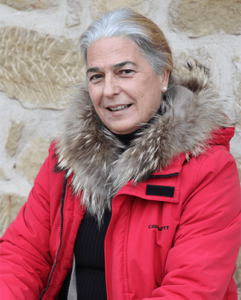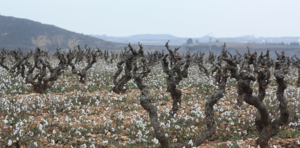Story and photos by Deborah Parker Wong
Within two years, consumers will begin seeing Rioja wines branded with the names of single vineyards that have been registered with the DOCa as Viñedos Singulares. After the sites have been defined by soil studies and vines older than 35 years, single vineyard wines must be hand-harvested at yields 20 percent lower than existing levels and made in unique lots that are assessed as “excellent” by a tasting panel.
Viñedos Singulares brand names and the names of wines produced in zones (de Zonas) and villages (de Pueblos) can now carry equal footing with Rioja itself on labels and will most likely be merged with traditional labelling terms that are based on aging requirements. In addition, the DOCa established minimum aging requirements for Reserva and Gran Reserva wines and has allowed the production of quality white and rosé sparkling wines.
While the ruling will allow producers of single vineyard wines to capitalize further on their terroir, according to Rioja USA Trade Director Ana Fabiano, there are 110,000 registered vineyards in Rioja and it’s estimated that less than one percent could qualify for the designation.

It’s being speculated that Telmo Rodríguez who produces Rioja wines at his family’s Remelluri winery with district names San Vicente and Labastida will be among the first to apply for the single vineyard designation but in an email interview Amaia Rodríguez said of Remelluri, “Our 204 vineyards are in two different villages – San Vicente de la Sonsierra and Labastida. Our soils, altitudes, orientations and varietals differ in each of the plots, and we blend it all. So, we do not fit in [the Viñedos Singulares] category.” Remelluri reverted to being an estate-grown wine with its release of 2009 Reserva. Currently, Rodríguez’ own wines under the Compania de Vinos de Telmo Rodríguez label use regional naming; his Lanzaga wines are all from the village of Lanciego which is declared on the labels.
Marta Bujanda of Familia Martínez Bujanda which has significant vineyard holdings in Rioja Alta, said, “We think the approval of the Viñedo Singular designation is very positive for us. Finca Valpiedra is an 80-hectare single vineyard in Rioja Alta which already belongs to Grandes Pagos de España (Great Single Vineyards of Spain). With this new designation we will be recognized as what we already are.” Bujanda anticipates applying for the designation in 2018 but not having single vineyard-designated wine in the market until 2021. The term Viñedo Singular will appear above the aging requirement on the front label and is anticipated to add value.

Rioja’s new regulations stand to benefit producers like Codorniu-Raventos which has been producing single vineyard wines from its estates in Rioja for at least forty years and also makes a wide range of wine styles including Cava. Diego Pinilla, Chief Winemaker for Codorniu-Raventos, said “At 250 hectares, Bilbaínas has the largest expanse of vineyards in Haro. Of the Haro village wines there are already several single estate vineyards such as Alto de la Caseta from the historical Viña Zaco, Viña Pomal Vinos Singulares Graciano from Vicuana and Tempranillo Blanco from Viña Paceta in our prestige portfolio.”
During a recent market visit to San Francisco, Pinilla showcased several wines including a particularly fine 2012 Viña Pomal Alto de la Caseta from the powerful Alta plateau and a 1978 Viña Pomal Gran Reserva, a wine that was dark and leafy with espresso, tobacco and iodine. He said, “In general, the wine consumer is demanding more personality, more uniqueness and searching for a sense of place. International styles have worked for several years but we’re seeing a different trend now, consumers are looking for wines that represent a place, a region or singular grapes typical from a specific appellation.”
Tradition has not stood in the way of one of Rioja’s oldest wineries, the Herederos del Marqués de Riscal which was founded in 1858 by Guillermo Hurtado de Amézaga. The original winery and Frank Gehry-designed Hotel Marqués de Riscal are located in Elciego, a southern village in the Rioja Alavesa province of Alava. According to Technical Manager Luis Hurtado de Amézaga, the winery’s sixth, this sub zone of the Rioja Alavesa has traditionally been known for producing wines with high acidity and good tannin structure with great ageing potential.

Marqués de Riscal produces one of Rioja’s best known, old-vine wines, Barón de Chirel. As the first Vino de Alta or high expression style wine made in Rioja, Chirel could well be called a “Super Rioja.” The 70% Tempranillo-dominate blend that includes Cabernet Sauvignon is sourced from the three-hectare Las Tapias vineyard and produced only in the best years. “In addition to Las Tapias, we also have several plots of Cabernet Sauvignon that we also use for Barón de Chirel, depending on the vintage, such as San Pelayo, Vialva, La Collada, la Bodega and Valle Bartolomé,” said Hurtado de Amézaga.
The current 2012 vintage was deeply black-fruited with chocolate on the nose and plummy, earthy notes of Cabernet Sauvignon making an appearance on the mid palate. Hurtado de Amézaga confirms that Marqués de Riscal will seek the viñedos singulars status for their vineyards. “Of course, we are going to embrace the possibility the legislation gives us for using the brands, not only for Las Tapias, but also some others that are included in the conditions the regulation requires,” he said.
After the nationwide ban on irrigation was lifted a few years ago, restrictions on the development of new vineyards in the DOCa were eased in January 2017 allowing farmers who own land to plant new vines without grubbing up existing sites. As such, Rioja is likely to expand by the one percent annual limit imposed by the European Union.

Those changes seem to have laid the groundwork for the approval of the production of white and rosé sparkling wine and the labelling of single vineyard wines. It’s not a stretch to see that fruit from younger vines will be used for sparkling production, leaving older vineyards intact to comply with the strict rules for single vineyard labelling.
The changes which stand to benefit producers in Rioja Alta and Rioja Alavesa look like a victory for the Asociacion Bodegas de Rioja Alavesa (ABRA), an organization that represents 115 small and mid-sized winemakers out of the 240 in the Rioja Alavesa. ABRA has lobbied the Consorzio to allow labelling that would help their members further define cru sites and be more competitive in the global marketplace.
